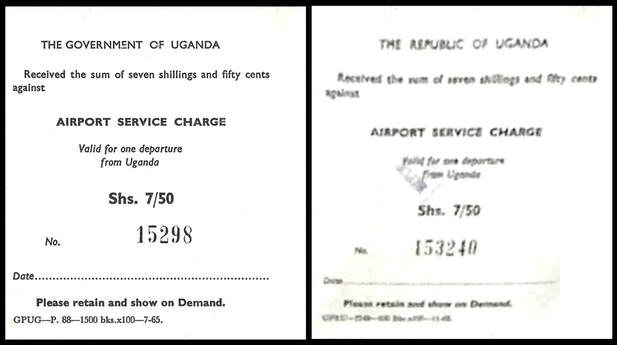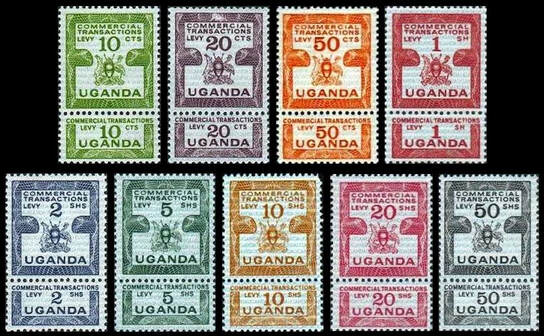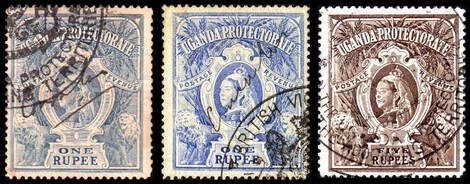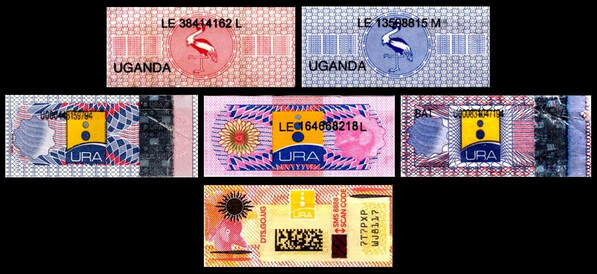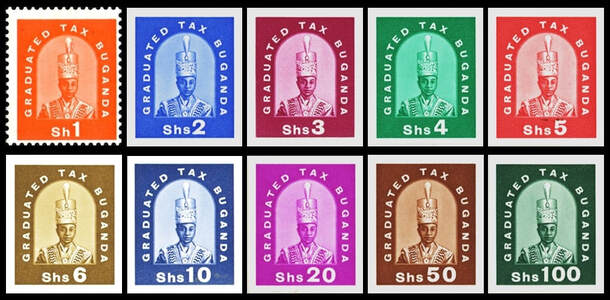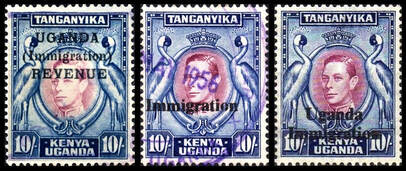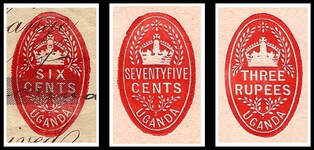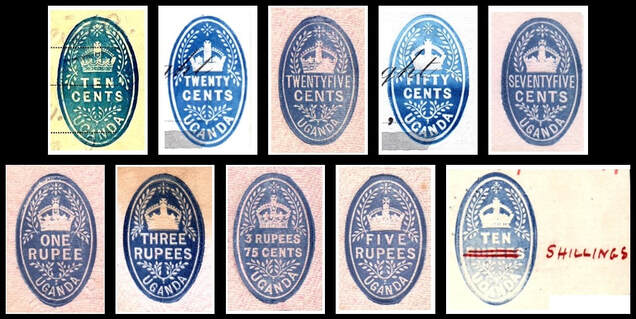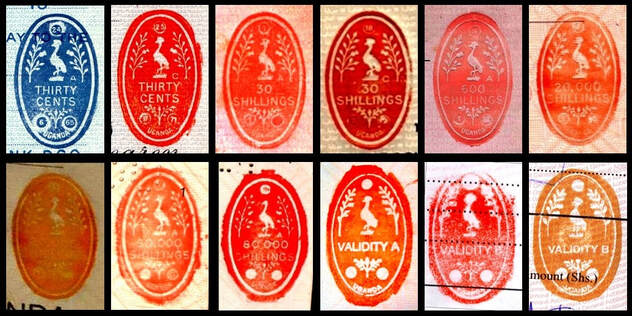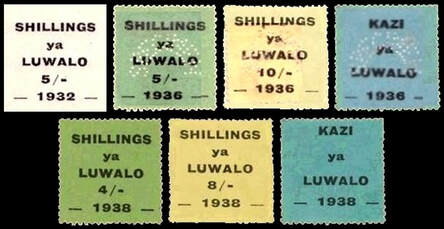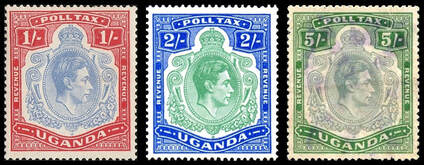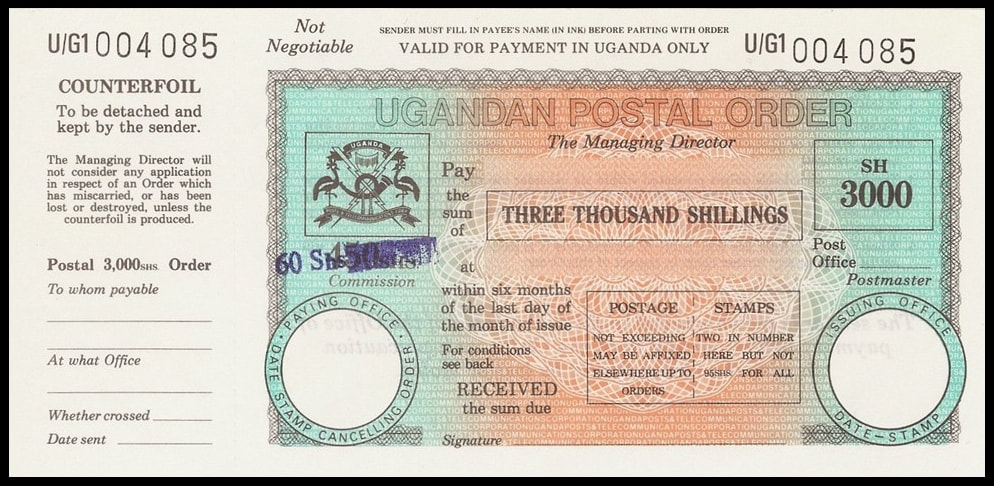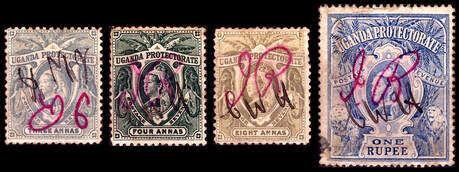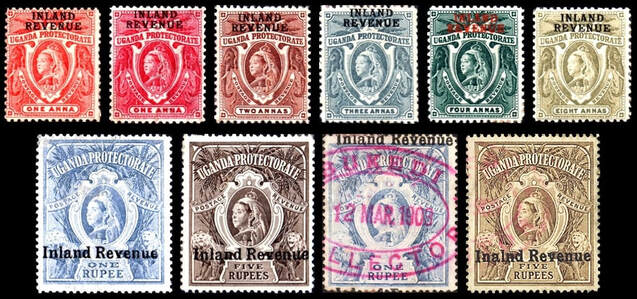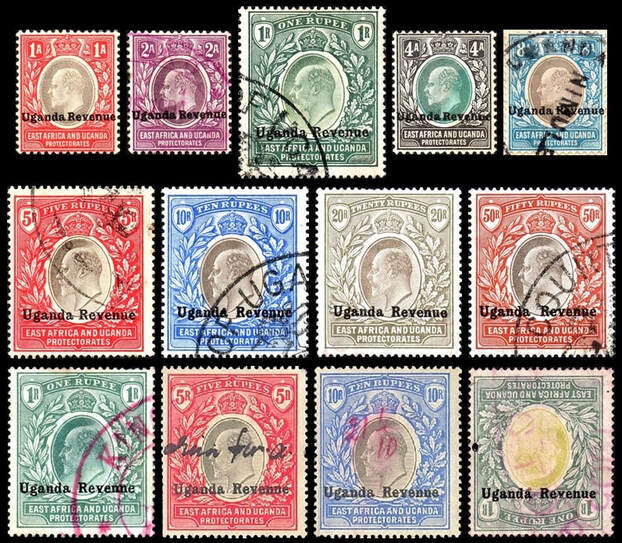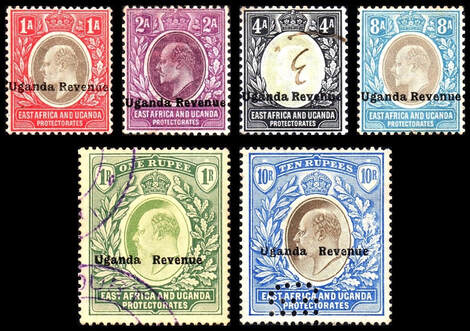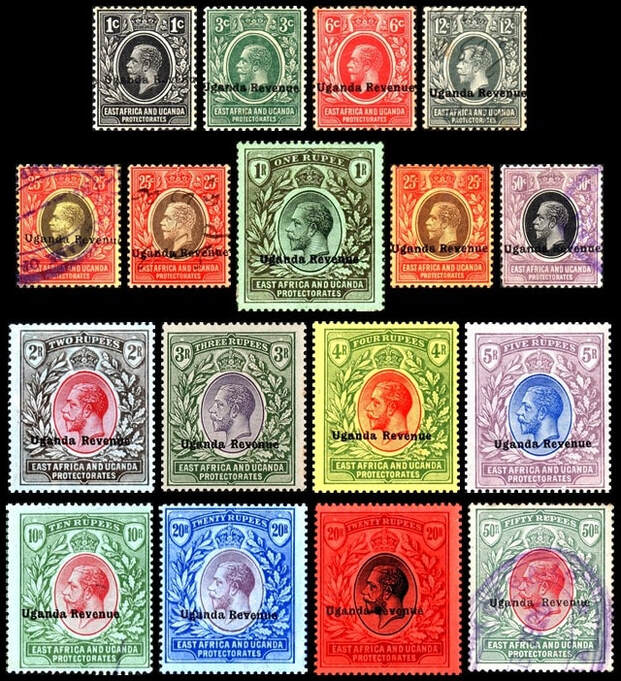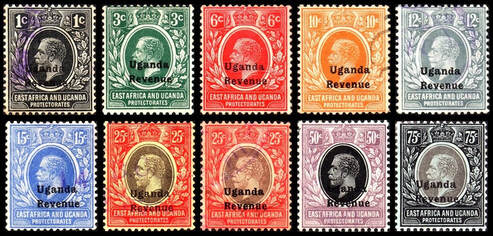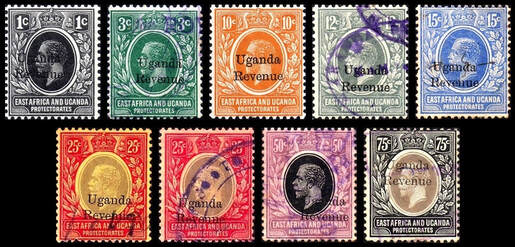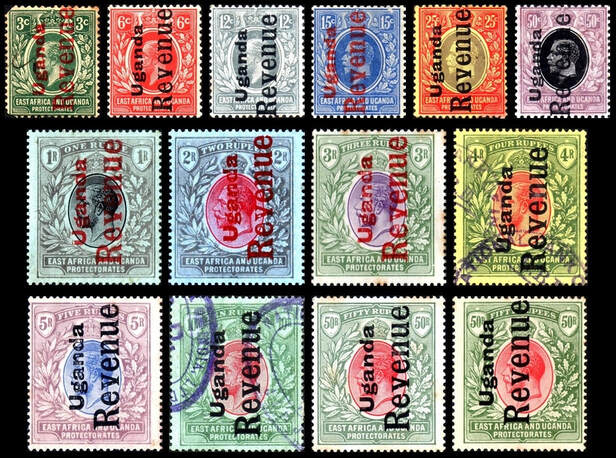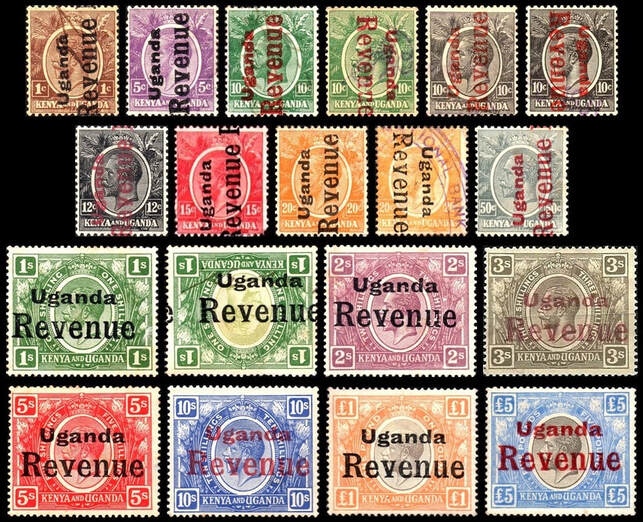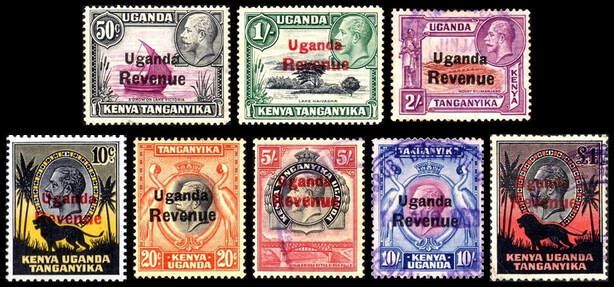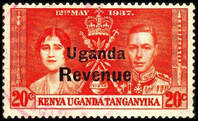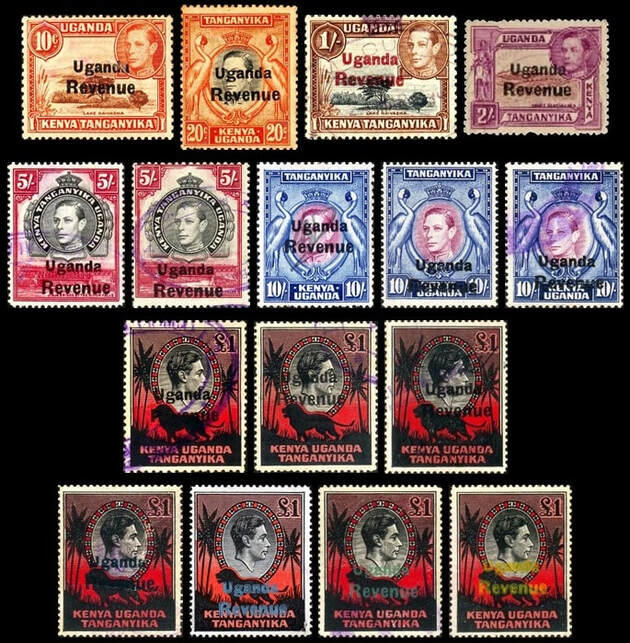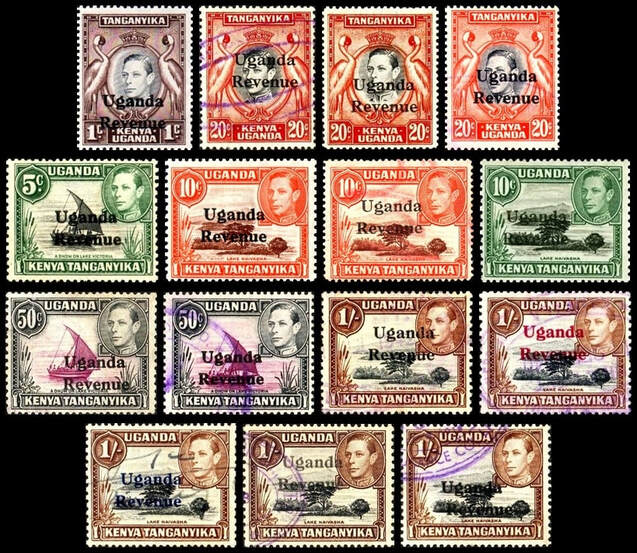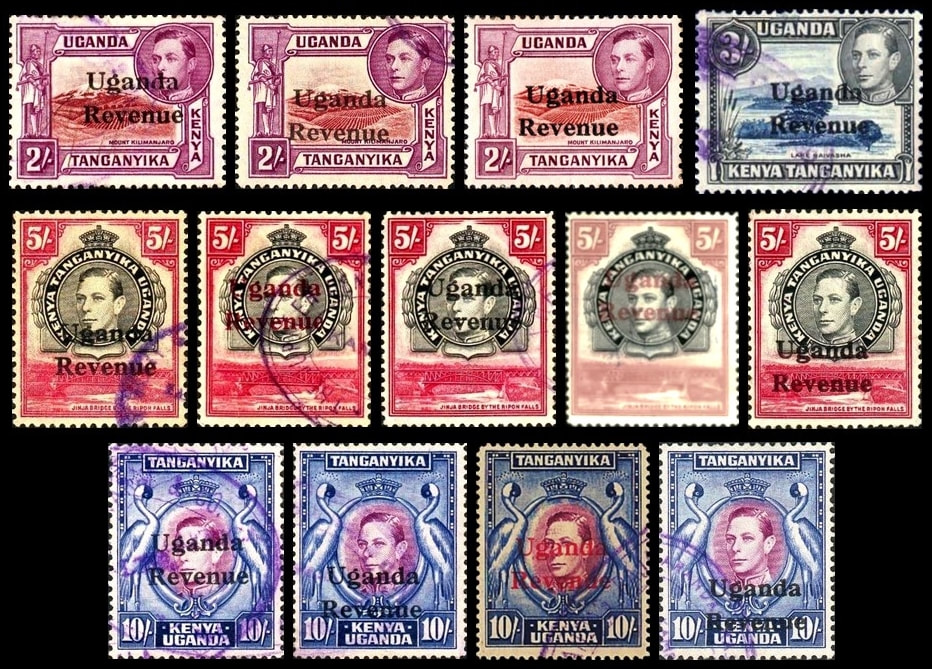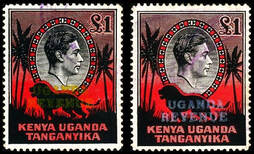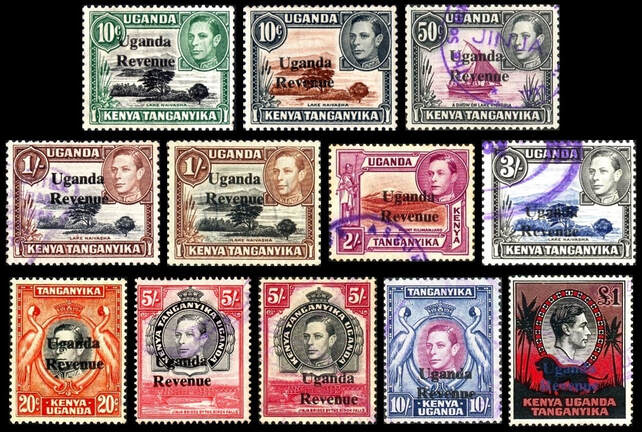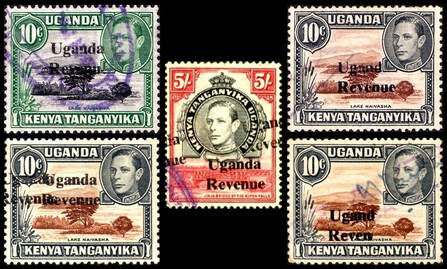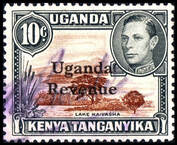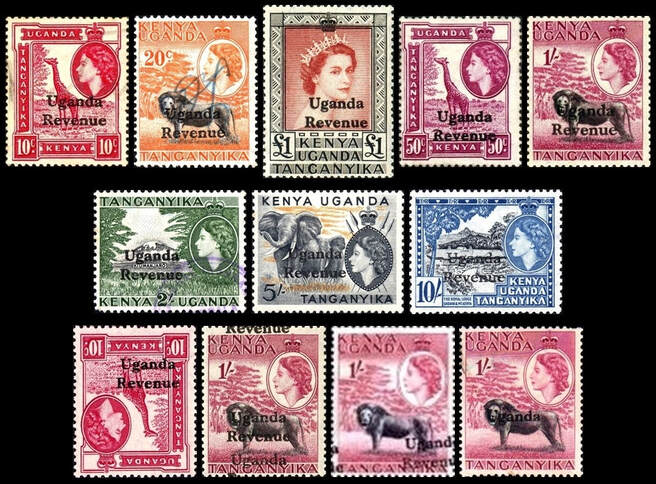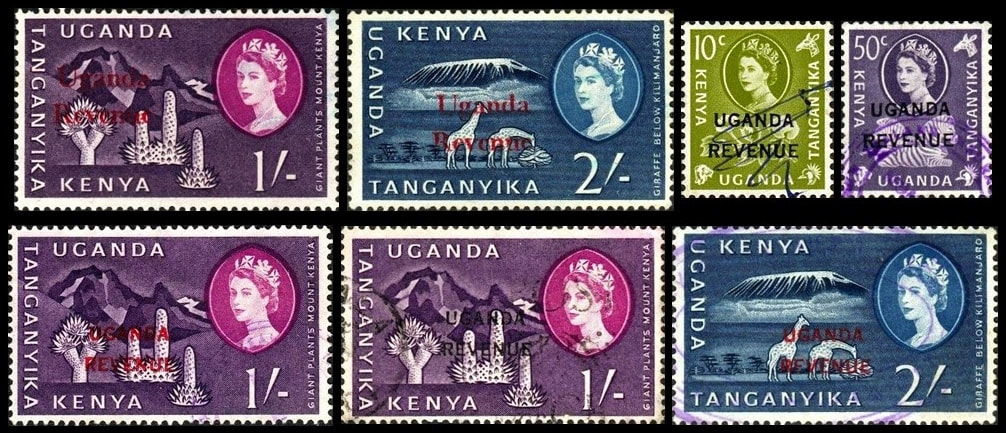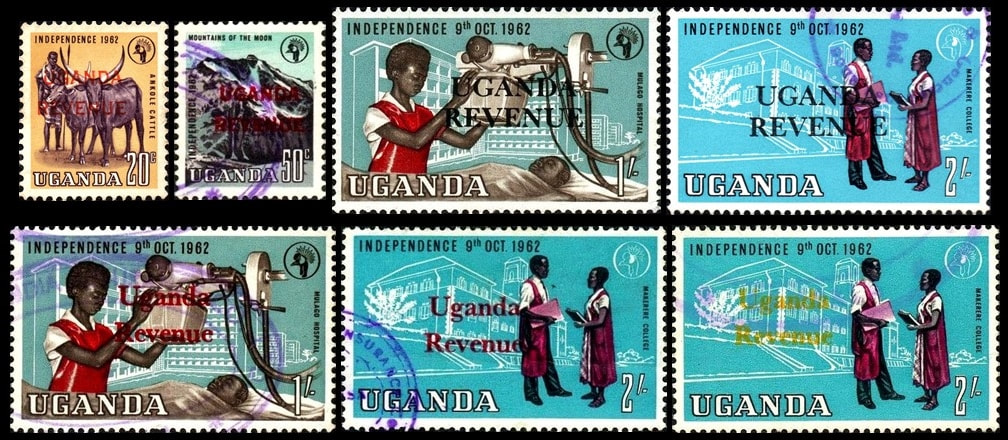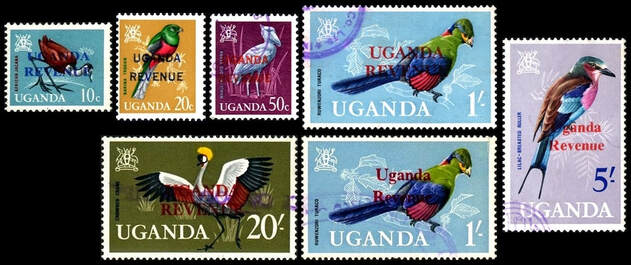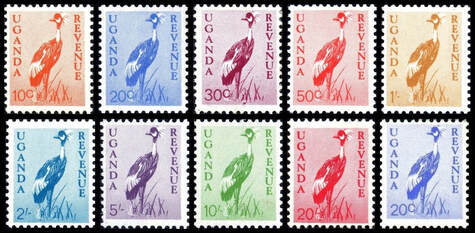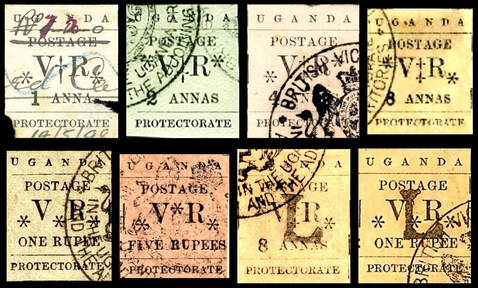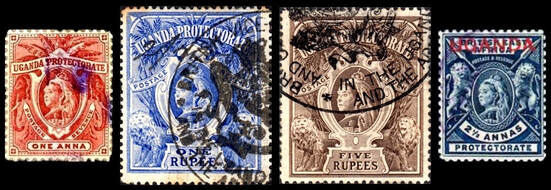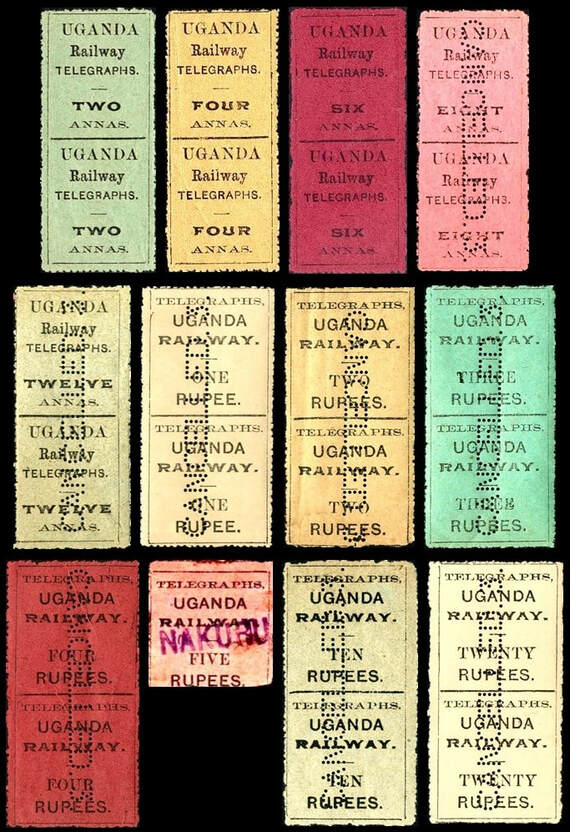Uganda
Chapter overview
- Airport Tax (catalogue numbers prefixed A)
- Commercial Transactions Levy (catalogue numbers prefixed L)
- Consular (catalogue numbers prefixed C)
- Excise (catalogue numbers prefixed X)
- Graduated Tax Buganda (catalogue numbers prefixed G)
- Immigration (catalogue numbers prefixed I)
- Impressed revenue stamps (catalogue numbers prefixed Z)
- Motor Driver's Licence (catalogue numbers prefixed M)
- Poll Tax (catalogue numbers prefixed P)
- Postal Order poundage (catalogue numbers prefixed O)
- Registration Fee (catalogue numbers prefixed Q)
- Revenue (catalogue numbers prefixed R)
- Revenue usage of Postage stamps (catalogue numbers prefixed S)
- Uganda Railway Telegraphs (catalogue numbers prefixed T)
For adhesive stamps inscribed Luwalo, see under Poll Tax.
Additional revenue stamps inscribed Uganda Registration Fee (which may be a postal issue) are referred to in the archives but no proofs or issued examples have surfaced to date.
Acknowledgments
- Taddeo Papi, 'Uganda 'Inland Revenue' Provisionals?', The Revenue Journal XXVIII 2 (September 2017), page 45
Special thanks to Harald Krieg, Ian Matheson, Taddeo Papi and Terry Russell for providing a number of scans for this chapter. For further acknowledgments see the main East Africa page.
Airport Tax
1965-68. Label inscribed AIRPORT SERVICE CHARGE Valid for one departure from Uganda. 75 x 89 mm. Imperf. No watermark. Serial number printed in black.
a) Inscribed THE GOVERNMENT OF UGANDA at top
A1. 7s50c black
b) Inscribed THE REPUBLIC OF UGANDA at top
A2. 7s50c black
Note: each label has a printing date in small font at foot: 7-65 (July 1965) for A1 and 11-68 (November 1968) for A2.
a) Inscribed THE GOVERNMENT OF UGANDA at top
A1. 7s50c black
b) Inscribed THE REPUBLIC OF UGANDA at top
A2. 7s50c black
Note: each label has a printing date in small font at foot: 7-65 (July 1965) for A1 and 11-68 (November 1968) for A2.
c1990s. Entebbe International Airport. 45 x 33 mm. Inscribed AIRPORT PASSENGER SERVICE CHARGE. Imperf. No watermark. Serial number in black.
A11. $20 multicoloured (orange-red background)
A12. $20 multicoloured (pale blue background)
A12 with handstamp surcharge reading 5% in violet.
A16. $20 multicoloured
Recorded usage: A11 - July 1998
A11. $20 multicoloured (orange-red background)
A12. $20 multicoloured (pale blue background)
A12 with handstamp surcharge reading 5% in violet.
A16. $20 multicoloured
Recorded usage: A11 - July 1998
Commercial Transactions Levy
1973. Arms of Uganda. 21 x 22½ mm, with tab 21 x 9½ mm attached at foot (normally detached when used). Perf 13½. No watermark. Security underprint UGANDA in turquoise. Printed (recess) by De La Rue.
L1. 10c yellowish green
L2. 20c brown-purple
L3. 50c yellow-orange
L4. 1s carmine
L5. 2s deep slate-blue
L6. 5s deep green
L7. 10s yellow-brown
L8. 20s red
L9. 50s black
Notes:
1. Archival pieces are known of all values, with the De La Rue marginal imprint and manuscript printing dates of November 1973. Plate numbers recorded:
L1. 10c yellowish green
L2. 20c brown-purple
L3. 50c yellow-orange
L4. 1s carmine
L5. 2s deep slate-blue
L6. 5s deep green
L7. 10s yellow-brown
L8. 20s red
L9. 50s black
Notes:
1. Archival pieces are known of all values, with the De La Rue marginal imprint and manuscript printing dates of November 1973. Plate numbers recorded:
- 1s 1A, 1E, 1G and 1H
- 2s 1B, 1D and 1F
- 5s 1A, 1D, 1G and 2B
- 10s 1F and 1H
- 20s 1D and 1F
- 50s 1G and 1H
Consular
c1896. Typeset postage stamps (produced by Revd F Rowling) with manuscript Consular overprint. Imperf. No watermark.
C1. 8a black
C2. 1r black
C3. 5r black
All known examples of these stamps are cancelled with the Coat of Arms cancel of the British Vice Consul in the Uganda Protectorate and the adjoining territories. There are various constant plate varieties on this issue.
C1. 8a black
C2. 1r black
C3. 5r black
All known examples of these stamps are cancelled with the Coat of Arms cancel of the British Vice Consul in the Uganda Protectorate and the adjoining territories. There are various constant plate varieties on this issue.
c1898. Similar manuscript Consular overprint on Queen Victoria stamp inscribed Uganda Protectorate. Perf 14. Watermark Crown CC.

C7 enlarged detail to show manuscript overprint
C6. 1r ultramarine
a. dull blue
C7. 5r brown
Note: the overprint on the 5r is often difficult to see against the dark background.
a. dull blue
C7. 5r brown
Note: the overprint on the 5r is often difficult to see against the dark background.
Excise
c2000-20. Various types. Imperf. No watermark. All with security number in black.
a) Crane, inscribed UGANDA in black
X1. [no value indicated] red
X2. [no value indicated] blue
b) Geometric patterns, inscribed URA
X11. [no value indicated] multicoloured, type 1
X12. [no value indicated] multicoloured, type 2
X13. [no value indicated] multicoloured, type 3
c) Sunburst and crane, inscribed URA and website address DTS.GO.UG
X21. [no value indicated] multicoloured
a) Crane, inscribed UGANDA in black
X1. [no value indicated] red
X2. [no value indicated] blue
b) Geometric patterns, inscribed URA
X11. [no value indicated] multicoloured, type 1
X12. [no value indicated] multicoloured, type 2
X13. [no value indicated] multicoloured, type 3
c) Sunburst and crane, inscribed URA and website address DTS.GO.UG
X21. [no value indicated] multicoloured
Graduated Tax Buganda
1963. King Mutesa II of Buganda. 17½ x 21 mm. Perf 14½ x 14. No watermark. Printed (photo) by Harrison.
G1. 1s orange
[G2. 2s blue]
[G3. 3s claret]
[G4. 4s emerald]
[G5. 5s red]
[G6. 6s olive-brown]
[G7. 10s slate-blue]
[G8. 20s magenta]
[G9. 50s purple-brown]
[G10. 100s myrtle]
Note: only the 1s value is known to date as an issued stamp. The others are known only as proofs.
Printings:
(Note: this list is probably incomplete and will be added to in future)
G1. 1s orange
[G2. 2s blue]
[G3. 3s claret]
[G4. 4s emerald]
[G5. 5s red]
[G6. 6s olive-brown]
[G7. 10s slate-blue]
[G8. 20s magenta]
[G9. 50s purple-brown]
[G10. 100s myrtle]
Note: only the 1s value is known to date as an issued stamp. The others are known only as proofs.
Printings:
- Req 279/1 (sent to Uganda 30th December 1962 to 23rd January 1963): 1s, 2s, 3s, 4s, 5s, 6s, 10s, 20s, 50s, 100s
- Req 4/21796/1 (sent to Uganda 29th May to 17th June 1964): 1s, 5s, 10s, 20s
- Req 6/14178/1 (date not recorded): 1s, 2s, 4s, 5s, 6s, 10s, 20s
(Note: this list is probably incomplete and will be added to in future)
Immigration
1949-64 (recorded usage). King George VI KUT pictorial stamp, overprinted in three different types for Immigration use. Watermark Multiple Script CA. Perf 13¼ x 13¾.
a) Opt UGANDA (Immigration) REVENUE
I1. 10s purple and blue
b) Opt Immigration
I6. 10s purple and blue
c) Opt Uganda Immigration
I11. 10s purple and blue
Notes:
1. These stamps were issued following the introduction of the "Immigration (Control) Ordinance" of 1947, and paid the fees for inter-territorial passes to Kenya and Tanganyika.
2. The overprints measure as follows:
a) Opt UGANDA (Immigration) REVENUE
I1. 10s purple and blue
b) Opt Immigration
I6. 10s purple and blue
c) Opt Uganda Immigration
I11. 10s purple and blue
Notes:
1. These stamps were issued following the introduction of the "Immigration (Control) Ordinance" of 1947, and paid the fees for inter-territorial passes to Kenya and Tanganyika.
2. The overprints measure as follows:
- I1 - UGANDA 12½ x 2 mm, (Immigration) 17½ x 2½ mm, REVENUE 15 x 2 mm - the first and third lines are identical to the overprint on R166/a (see below)
- I6 - Immigration 18½ x 2½ mm
- I11 - Uganda 11½ x 3 mm, Immigration 18½ x 2½ mm - this overprint is as I6 with Uganda added
Impressed
1918-60s (see note 1). Crown and leaves. 17½ x 29 mm.
a) Printed in vermilion, denominated in cents and rupees
Z1. 6c vermilion
Z7. 75c vermilion
Z11. 3r vermilion
a) Printed in vermilion, denominated in cents and rupees
Z1. 6c vermilion
Z7. 75c vermilion
Z11. 3r vermilion
b) Printed in blue, denominated in cents and rupees
Z21. 10c blue
Z22. 20c blue
Z23. 25c blue
Z24. 50c blue
Z25. 75c blue
Z26. 1r blue
Z27. 3r blue
Z28. 3r75c blue
Z29. 5r blue
[Z30. 10r blue]
Z21. 10c blue
Z22. 20c blue
Z23. 25c blue
Z24. 50c blue
Z25. 75c blue
Z26. 1r blue
Z27. 3r blue
Z28. 3r75c blue
Z29. 5r blue
[Z30. 10r blue]
c) Printed in blue, denominated in shillings
Z41. 1s blue
Z42. 2s blue
Z43. 3s blue
Z46. 10s blue
Z48. 30s blue
Notes:
1. The use of impressed stamps was authorised in 1918 by Uganda Government Ordinance No 90 and presumably began around that date. Illustrated below is a set of 22 proofs in vermilion from 1c to 500r, including apparently odd denominations which correspond to sixteenths of a rupee (Indian annas, eg 37c=6 annas and 62c=10 annas). The vast majority of these values are not known as issued stamps.
2. The blue stamps are presumed to have been issued later, and are known used between 1930 (10c) and 1961 (20c). Barber also lists the 20r in blue, which I have not seen.
3. An essay for the 10 shilling value is illustrated, based on the 10 rupees value with the new denomination handwritten in red ink. The 10r is not recorded as an issued stamp.
4. The shape of the crown and the position of the leaves differ slightly from one value to another.
Z41. 1s blue
Z42. 2s blue
Z43. 3s blue
Z46. 10s blue
Z48. 30s blue
Notes:
1. The use of impressed stamps was authorised in 1918 by Uganda Government Ordinance No 90 and presumably began around that date. Illustrated below is a set of 22 proofs in vermilion from 1c to 500r, including apparently odd denominations which correspond to sixteenths of a rupee (Indian annas, eg 37c=6 annas and 62c=10 annas). The vast majority of these values are not known as issued stamps.
2. The blue stamps are presumed to have been issued later, and are known used between 1930 (10c) and 1961 (20c). Barber also lists the 20r in blue, which I have not seen.
3. An essay for the 10 shilling value is illustrated, based on the 10 rupees value with the new denomination handwritten in red ink. The 10r is not recorded as an issued stamp.
4. The shape of the crown and the position of the leaves differ slightly from one value to another.
1965-2017 (recorded usage). New type featuring crowned crane and incorporating date plugs. 18 x 29½ mm.
Z51. 30c blue (Die A)
Z52. 30c vermilion (Die C)
Z56. 30s vermilion (Die A)
a. Die C (1981)
Z61. 600s vermilion (Die A) (1982)
Z71. 20,000s vermilion (no die letter)
Z72. 30,000s vermilion (no die letter)
Z73. 50,000s vermilion (Die A) (2005)
Z74. 80,000s vermilion (Die A)
Z81. [Validity A] vermilion (Die A)
Z82. [Validity B] vermilion (Die A)
a. Orange-brown (redrawn)
Notes:
1. Barber also lists the 30c die B in vermilion, which I have not seen.
2. It seems reasonable to guess that other values may exist!
3. In Z82a the crane and inscriptions are smaller than in Z51/82.
Recorded usage: 30c blue (1965), 30c vermilion (1971), 30s A (1995), 30s C (1981), 600s (1982), 20K (1990-93), 50K (2002-05), 80K (2017).
Z51. 30c blue (Die A)
Z52. 30c vermilion (Die C)
Z56. 30s vermilion (Die A)
a. Die C (1981)
Z61. 600s vermilion (Die A) (1982)
Z71. 20,000s vermilion (no die letter)
Z72. 30,000s vermilion (no die letter)
Z73. 50,000s vermilion (Die A) (2005)
Z74. 80,000s vermilion (Die A)
Z81. [Validity A] vermilion (Die A)
Z82. [Validity B] vermilion (Die A)
a. Orange-brown (redrawn)
Notes:
1. Barber also lists the 30c die B in vermilion, which I have not seen.
2. It seems reasonable to guess that other values may exist!
3. In Z82a the crane and inscriptions are smaller than in Z51/82.
Recorded usage: 30c blue (1965), 30c vermilion (1971), 30s A (1995), 30s C (1981), 600s (1982), 20K (1990-93), 50K (2002-05), 80K (2017).

The impressions illustrated here can be found on cheques in the 1970s-80s.
No value is indicated so the same types could be used regardless of increasing rates.
Motor Driver's Licence
1933-35 (recorded usage). Revenue stamps further overprinted Motor Driver's Licence in mixed case, 29 x 2 mm. Perf 14. Wmk Multiple Script CA (sideways).
a) On revenue stamp previously overprinted Uganda Revenue in mixed case (1933)
M1. 5s carmine-red (Motor Driver's Licence opt at top)
a. Motor Driver's Licence opt at foot
b) On revenue stamp previously overprinted UGANDA REVENUE in capitals (1935)
M6. 5s carmine-red
1937 (earliest recorded usage). King George V pictorial stamp, overprinted UGANDA REVENUE MOTOR DRIVER'S LICENCE in blue. Perf 13. Wmk Multiple Script CA.
M11. 5s black and carmine
a) On revenue stamp previously overprinted Uganda Revenue in mixed case (1933)
M1. 5s carmine-red (Motor Driver's Licence opt at top)
a. Motor Driver's Licence opt at foot
b) On revenue stamp previously overprinted UGANDA REVENUE in capitals (1935)
M6. 5s carmine-red
1937 (earliest recorded usage). King George V pictorial stamp, overprinted UGANDA REVENUE MOTOR DRIVER'S LICENCE in blue. Perf 13. Wmk Multiple Script CA.
M11. 5s black and carmine
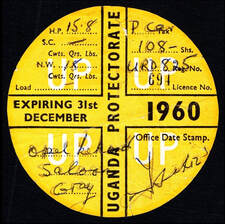
Tax discs such as the one iIllustrated here (dated 1960) were used in Uganda before Independence.
The amount of tax paid is not indicated.
Poll Tax
The Luwalo proofs and specimen stamps illustrated here may represent a precursor to the Poll Tax issues bearing the King's portrait. Luwalo was a kind of labour-related tax imposed during the Colonial era, but the details are hard to ascertain. According to the Crown Agents records, Luwalo stamps denominated 5s, 10s and Kazi (=work, ie tax paid in kind by manual labour) were printed each year from 1932 to 1937, then 4s, 8s and Kazi in 1938. All stamps share a common design consisting of plain text printed in black, the 4s and 5s values being printed on green paper, the 8s and 10s on buff and the Kazi stamps on blue. A complete set of these stamps can be found in the Foreign and Commonwealth Office collection in the British Library, but no issued examples are known to have survived.
1940-1952. Large Nyasa key type featuring the portrait of King George VI. 25½ x 30 mm. Perf 14. Watermark Multiple Script CA. Printed (typo) by De La Rue.
P1. 1s blue and carmine (1940)
P2. 2s green and ultramarine (1940)
[a. Perf 13 (1952)]
P3. 5s pale grey and deep green (1944)
Notes:
1. The 1s and 2s were first printed in December 1939, then reprinted in 1941, 1943 and 1945. The 5s was added as a new value in 1944 but not reprinted. A final reprint of the 2s was sent to Uganda in November 1952, by which time De La Rue had changed their main perforator from 14-gauge to 13-gauge. P2a is therefore presumed to exist from this last printing, though no examples have yet been recorded.
2. The 2s (perf 14) is known postally used on a philatelic cover.
P1. 1s blue and carmine (1940)
P2. 2s green and ultramarine (1940)
[a. Perf 13 (1952)]
P3. 5s pale grey and deep green (1944)
Notes:
1. The 1s and 2s were first printed in December 1939, then reprinted in 1941, 1943 and 1945. The 5s was added as a new value in 1944 but not reprinted. A final reprint of the 2s was sent to Uganda in November 1952, by which time De La Rue had changed their main perforator from 14-gauge to 13-gauge. P2a is therefore presumed to exist from this last printing, though no examples have yet been recorded.
2. The 2s (perf 14) is known postally used on a philatelic cover.
Postal Order poundage
Illustrated here is a Ugandan Postal Order for 3000 shillings, on which poundage of 60 shillings. A wide range of values are known in this type including 100s, 1000s and 1500s. Such items are not listed on this website but further information can be obtained from the Postal Order Society.
Registration Fee
No issued stamps are recorded to date, but the Foreign and Commonwealth Collection in the British Library includes four stamps of this appropriation annotated 'Received 8.10.58'. The stamps are the QEII first definitive issue of KUT 2s, 5s, 10s and £1 overprinted Uganda Registration Fee in a style similar to R195/8.
No issued stamps are recorded to date, but the Foreign and Commonwealth Collection in the British Library includes four stamps of this appropriation annotated 'Received 8.10.58'. The stamps are the QEII first definitive issue of KUT 2s, 5s, 10s and £1 overprinted Uganda Registration Fee in a style similar to R195/8.
Revenue
Notes: all Revenue issues except the final Crowned Crane type (R271ff) were produced by overprinting postage stamps. At least some of this work was done by the Government Printer, as is clear from Uganda Government Ordinances 90 (1918) and 540 (1926). Unfortunately there are no known surviving records of the overprinting, meaning that dates of issue, quantities and even the values overprinted cannot be known with certainty. Dates of issue shown in this listing refer usually to the issue of the equivalent (unoverprinted) postage issue, though it is possible that the overprinted revenue stamps in fact appeared later.
Since Uganda always overprinted stamps for general-duty revenue purposes, the fiscal use of unoverprinted dual-purpose (postage and revenue) stamps is almost unknown.
Notes: all Revenue issues except the final Crowned Crane type (R271ff) were produced by overprinting postage stamps. At least some of this work was done by the Government Printer, as is clear from Uganda Government Ordinances 90 (1918) and 540 (1926). Unfortunately there are no known surviving records of the overprinting, meaning that dates of issue, quantities and even the values overprinted cannot be known with certainty. Dates of issue shown in this listing refer usually to the issue of the equivalent (unoverprinted) postage issue, though it is possible that the overprinted revenue stamps in fact appeared later.
Since Uganda always overprinted stamps for general-duty revenue purposes, the fiscal use of unoverprinted dual-purpose (postage and revenue) stamps is almost unknown.
Illustrated here are four values of the Uganda 1898-1902 postage issue with the letters I.R. in manuscript. The stamps are endorsed with the initials of Charles William Hattersley, a missionary from Sheffield who was sent to Uganda in 1897 by the Church Missionary Society. Taddeo Papi in a 2017 article for The Revenue Journal queries whether these may be Uganda's first revenue stamps, the letters I.R. standing for Inland Revenue. I would welcome further information from any reader.
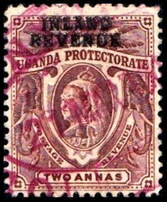 R2a (enlarged to show error)
R2a (enlarged to show error)
April 1901 (earliest recorded usage). Queen Victoria stamps inscribed Uganda Protectorate, overprinted Inland Revenue. Perf 14.
a) Wmk Crown CA; overprinted in capitals 1½ mm high
R1. 1a scarlet
a. Carmine-rose
R2. 2a red-brown
a. Overprint doubled
R3. 3a pale grey
R4. 4a deep green (red)
R5. 8a pale olive
b) Wmk Crown CC; overprinted in mixed case, 24 x 2½ mm
R6. 1r dull blue
a. Overprint at top
R7. 5r brown
a. Error Inalnd
Notes:
1. Morley lists the 1r in two different shades - ultramarine and bright blue, though all examples I have seen are dull blue. Forbin lists the 5r with overprint variety Inaland, but this is almost certainly a mistranscription for R7a.
2. R1 is known used on a postal cover to Entebbe, though this is probably philatelic.
3. In his written-up album pages Ian Gibson suggested that the need for overprinting these stamps arose when the postal services of British East Africa and Uganda were amalgamated on 1st April 1901. The earliest recorded usage is an example of R6 cancelled on 13th April 1901 in Wadelai.
a) Wmk Crown CA; overprinted in capitals 1½ mm high
R1. 1a scarlet
a. Carmine-rose
R2. 2a red-brown
a. Overprint doubled
R3. 3a pale grey
R4. 4a deep green (red)
R5. 8a pale olive
b) Wmk Crown CC; overprinted in mixed case, 24 x 2½ mm
R6. 1r dull blue
a. Overprint at top
R7. 5r brown
a. Error Inalnd
Notes:
1. Morley lists the 1r in two different shades - ultramarine and bright blue, though all examples I have seen are dull blue. Forbin lists the 5r with overprint variety Inaland, but this is almost certainly a mistranscription for R7a.
2. R1 is known used on a postal cover to Entebbe, though this is probably philatelic.
3. In his written-up album pages Ian Gibson suggested that the need for overprinting these stamps arose when the postal services of British East Africa and Uganda were amalgamated on 1st April 1901. The earliest recorded usage is an example of R6 cancelled on 13th April 1901 in Wadelai.
 R15a/17a Revenne error (detail)
R15a/17a Revenne error (detail)
c1903-04. King Edward VII stamps inscribed East Africa and Uganda Protectorates, overprinted Uganda Revenue in a single line. Perf 14. Wmk Crown CA (annas values) or Crown CC (rupees).
a) Overprint 19 x 2 mm
R11. 1a grey and red
R12. 2a dull and bright purple
R13. 4a grey-green and black
R14. 8a grey and pale blue
b) Overprint 22½ x 2½ mm
R15. 1r green
a. Error Revenne for Revenue
b. Overprint inverted
R16. 5r grey and red
a. Error Revenne for Revenue
R17. 10r grey and ultramarine
a. Error Revenne for Revenue
R18. 20r grey and stone
R19. 50r grey and red-brown
a) Overprint 19 x 2 mm
R11. 1a grey and red
R12. 2a dull and bright purple
R13. 4a grey-green and black
R14. 8a grey and pale blue
b) Overprint 22½ x 2½ mm
R15. 1r green
a. Error Revenne for Revenue
b. Overprint inverted
R16. 5r grey and red
a. Error Revenne for Revenue
R17. 10r grey and ultramarine
a. Error Revenne for Revenue
R18. 20r grey and stone
R19. 50r grey and red-brown
c1904-07. As previous issue but watermark Multiple Crown CA. Overprint 19 x 2 mm on anna values. The rupee values have the same overprint but with wider horizontal spacing between Uganda and Revenue, giving overall length 20 mm. (This overprint is smaller than on the rupee values of the c1903-04 issue.)
R21. 1a grey and red
R22. 2a dull and bright purple
R23. 4a grey-green and black
R24. 8a grey and pale blue
R25. 1r green
R26. 10r grey and ultramarine
Note: Forbin lists the 5r in this watermark, but I have not seen this.
R21. 1a grey and red
R22. 2a dull and bright purple
R23. 4a grey-green and black
R24. 8a grey and pale blue
R25. 1r green
R26. 10r grey and ultramarine
Note: Forbin lists the 5r in this watermark, but I have not seen this.
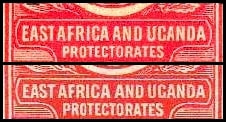
c1907-10. As previous issue but currency changed to cents. Uganda Revenue opt 19 x 2 mm. Perf 14. Watermark Multiple Crown CA.
R31. 1c brown
R32. 3c grey-green
R33. 6c red
a. Single-plate printing (1910)
R34. 25c grey-green and black
R35. 50c grey-green and orange-brown
Note: the 1910 single-plate printing (SG 43) of the 6c has a fine white line below the flowers to left and right of the base of the medallion. The lettering is also slightly different, as shown in the illustration.
R31. 1c brown
R32. 3c grey-green
R33. 6c red
a. Single-plate printing (1910)
R34. 25c grey-green and black
R35. 50c grey-green and orange-brown
Note: the 1910 single-plate printing (SG 43) of the 6c has a fine white line below the flowers to left and right of the base of the medallion. The lettering is also slightly different, as shown in the illustration.
c1912-21. King George V stamps inscribed East Africa and Uganda Protectorates with single-line Uganda Revenue overprint 19 x 2 mm. Perf 14. Watermark Multiple Crown CA.
R41. 1c black
R42. 3c green
R43. 6c red
R44. 12c slate-grey
R45. 25c black and red on yellow
a. White back
b. On lemon
R46. 50c black and lilac
R47. 1r black on green
R48. 2r red and black on blue
R49. 3r violet and green
R50. 4r red and green on yellow
R51. 5r blue and dull purple
R52. 10r red and green on green
R53. 20r black and purple on red
R54. 20r purple and blue on blue
R55. 50r carmine and green
R41. 1c black
R42. 3c green
R43. 6c red
R44. 12c slate-grey
R45. 25c black and red on yellow
a. White back
b. On lemon
R46. 50c black and lilac
R47. 1r black on green
R48. 2r red and black on blue
R49. 3r violet and green
R50. 4r red and green on yellow
R51. 5r blue and dull purple
R52. 10r red and green on green
R53. 20r black and purple on red
R54. 20r purple and blue on blue
R55. 50r carmine and green
1918 (according to Gibson). As previous issue but Uganda Revenue overprint in two lines 2 mm high, with Revenue 9½ mm long. Perf 14. Watermark Multiple Crown CA.
R61. 1c black
R62. 3c green
R63. 6c red
R64. 10c yellow-orange
R65. 12c slate-grey
R66. 15c bright blue
R67. 25c black and red on yellow
a. On orange-buff
R68. 50c black and lilac
R69. 75c black on green
There are minor variations in the relative horizontal positions of the two lines of overprint.
R61. 1c black
R62. 3c green
R63. 6c red
R64. 10c yellow-orange
R65. 12c slate-grey
R66. 15c bright blue
R67. 25c black and red on yellow
a. On orange-buff
R68. 50c black and lilac
R69. 75c black on green
There are minor variations in the relative horizontal positions of the two lines of overprint.
1918 (according to Gibson). As previous issue but two-line Uganda Revenue overprint redrawn slightly larger, 2½ mm high, with Revenue 10½ mm long. Perf 14. Watermark Multiple Crown CA.
R71. 1c black
R72. 3c green
R74. 10c yellow-orange
R75. 12c slate-grey
R76. 15c bright blue
R77. 25c black and red on yellow
a. White back
R78. 50c black and lilac
R79. 75c black on green
R71. 1c black
R72. 3c green
R74. 10c yellow-orange
R75. 12c slate-grey
R76. 15c bright blue
R77. 25c black and red on yellow
a. White back
R78. 50c black and lilac
R79. 75c black on green
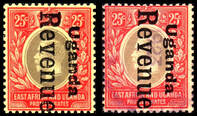 R85a/b
R85a/b
c1912-22. King George V stamps inscribed East Africa and Uganda Protectorates with two-line seriffed Uganda Revenue overprint sideways, normally reading upwards. Watermark Multiple Script CA (3r, 5r, second 50r) or Multiple Crown CA (others). Perf 14.
a) Uganda 15 x 3 mm, Revenue 22 x 4½ mm
R81. 3c green
R82. 6c red
R83. 12c slate-grey
R84. 15c bright blue (red opt)
R85. 25c black and red on yellow
a. Overprint reading downwards
b. White back, opt reading downwards
R86. 50c black and lilac
b) Uganda 19 x 4 mm, Revenue 27 x 5½ mm
R87. 1r black on green (red opt)
R88. 2r red and black on blue (red opt)
R89. 3r violet and green (wmk Multiple Script CA) (red opt)
R90. 4r red and green on yellow
R91. 5r blue and dull purple (wmk Multiple Script CA)
R92. 10r red and green on green
R93. 50r dull rose-red and dull greyish green (wmk Multiple Crown CA)
R94. 50r carmine and green (wmk Multiple Script CA)
Note: Gibson also lists the 2r with overprint reading downwards, but I have not seen this. He also lists a 10c black and 20c orange in this set, but these were not printed in these colours for the East Africa & Uganda postage and revenue issue so must belong to the next series.
a) Uganda 15 x 3 mm, Revenue 22 x 4½ mm
R81. 3c green
R82. 6c red
R83. 12c slate-grey
R84. 15c bright blue (red opt)
R85. 25c black and red on yellow
a. Overprint reading downwards
b. White back, opt reading downwards
R86. 50c black and lilac
b) Uganda 19 x 4 mm, Revenue 27 x 5½ mm
R87. 1r black on green (red opt)
R88. 2r red and black on blue (red opt)
R89. 3r violet and green (wmk Multiple Script CA) (red opt)
R90. 4r red and green on yellow
R91. 5r blue and dull purple (wmk Multiple Script CA)
R92. 10r red and green on green
R93. 50r dull rose-red and dull greyish green (wmk Multiple Crown CA)
R94. 50r carmine and green (wmk Multiple Script CA)
Note: Gibson also lists the 2r with overprint reading downwards, but I have not seen this. He also lists a 10c black and 20c orange in this set, but these were not printed in these colours for the East Africa & Uganda postage and revenue issue so must belong to the next series.
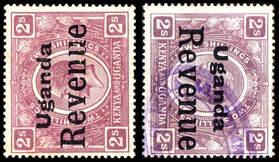 R109/a
R109/a
c1922-27. King George V stamps inscribed Kenya and Uganda, with currency now in East African shillings instead of rupees. Two-line seriffed Uganda Revenue overprint similar to previous issue. Perf 14. Watermark Multiple Script CA (sideways on shilling and pound values, with crown to the left of CA when seen from the back of the stamp).
a) Opt sideways (normally reading upwards), Uganda 15 x 3 mm, Revenue 22 x 4½ mm
R101. 1c deep brown
R102. 5c violet
R103. 10c green (red)
a. Overprint reading downwards
R104. 10c black (red)
a. Overprint reading downwards
R105. 12c jet-black (red)
R105a. 15c rose-carmine
R106. 20c dull orange-yellow
a. Overprint reading downwards
R107. 50c grey (red)
b) Opt upright, Uganda 19 x 4 mm, Revenue 27 x 5½ mm
R108. 1s green
a. Overprint inverted
R109. 2s dull purple
a. Wmk Crown to right of CA
R110. 3s brownish grey (red)
R111. 5s carmine-red
R112. 10s bright blue (red)
R113. £1 black and orange
R114. £5 black and blue (red)
Note: Gibson lists a 12c with overprint reading downwards, but I have not seen this.
a) Opt sideways (normally reading upwards), Uganda 15 x 3 mm, Revenue 22 x 4½ mm
R101. 1c deep brown
R102. 5c violet
R103. 10c green (red)
a. Overprint reading downwards
R104. 10c black (red)
a. Overprint reading downwards
R105. 12c jet-black (red)
R105a. 15c rose-carmine
R106. 20c dull orange-yellow
a. Overprint reading downwards
R107. 50c grey (red)
b) Opt upright, Uganda 19 x 4 mm, Revenue 27 x 5½ mm
R108. 1s green
a. Overprint inverted
R109. 2s dull purple
a. Wmk Crown to right of CA
R110. 3s brownish grey (red)
R111. 5s carmine-red
R112. 10s bright blue (red)
R113. £1 black and orange
R114. £5 black and blue (red)
Note: Gibson lists a 12c with overprint reading downwards, but I have not seen this.
c1922-27. As previous issue but smaller sans-serif overprint on cents values, and shillings values overprinted in sans-serif capitals. Perf 14. Watermark Multiple Script CA (sideways on shilling values).
a) Opt sideways (reading upwards), Uganda 12 x 3 mm, Revenue 15 x 3 mm
R122. 10c black (red)
R123. 20c orange-yellow
b) Opt upright in capitals, UGANDA 15½ x 2½ mm, REVENUE 22 x 3 mm
R126. 1s green
R127. 2s dull purple
R128. 5s carmine-red
Note: Gibson lists a 10c green, but I have not seen this. Gibson also illustrates my R126 but fails to note that the shilling values are overprinted in capitals. This seems to have caused Barefoot to list (mistakenly) a 1s and 2s with the mixed-case overprint similar to R122/3.
a) Opt sideways (reading upwards), Uganda 12 x 3 mm, Revenue 15 x 3 mm
R122. 10c black (red)
R123. 20c orange-yellow
b) Opt upright in capitals, UGANDA 15½ x 2½ mm, REVENUE 22 x 3 mm
R126. 1s green
R127. 2s dull purple
R128. 5s carmine-red
Note: Gibson lists a 10c green, but I have not seen this. Gibson also illustrates my R126 but fails to note that the shilling values are overprinted in capitals. This seems to have caused Barefoot to list (mistakenly) a 1s and 2s with the mixed-case overprint similar to R122/3.
c1935-37. King George V pictorial stamps inscribed Kenya Uganda Tanganyika, with two-line sans-serif Uganda Revenue overprint (Uganda 12 x 3 mm, Revenue 15 x 3 mm). Perf 12 x 13 (10c and £1), perf 14 (50c and 1s), perf 13 (others). Watermark Multiple Script CA.
R131. 10c black and yellow (red)
R132. 20c black and orange
R133. 50c bright purple and black
R134. 1s black and green (red)
R135. 2s lake and purple
R136. 5s black and carmine (red)
R137. 10s purple and blue
R138. £1 black and red (red)
Note: Barefoot lists the 50c with variety missing final a in Uganda, but I have not seen this.
R131. 10c black and yellow (red)
R132. 20c black and orange
R133. 50c bright purple and black
R134. 1s black and green (red)
R135. 2s lake and purple
R136. 5s black and carmine (red)
R137. 10s purple and blue
R138. £1 black and red (red)
Note: Barefoot lists the 50c with variety missing final a in Uganda, but I have not seen this.
1937-c1944 (see note 1). King George VI stamps inscribed Kenya Uganda Tanganyika, with two-line sans-serif Uganda Revenue overprint (Uganda 12 x 3 mm, Revenue 15 x 3 mm). Watermark Multiple Script CA. Overprint in black unless otherwise stated.
a) On Coronation commemorative stamp of 1937
R139. 20c orange
a) On Coronation commemorative stamp of 1937
R139. 20c orange
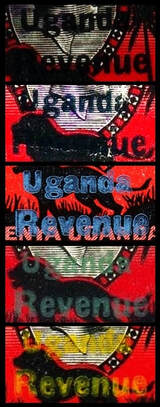 R147b/f showing different opt colours
R147b/f showing different opt colours
b) On pictorial definitive issue, various perfs
R141. 10c red-brown and orange (perf 13 x 11¾)
R142. 20c black and orange (perf 13¼)
R143. 1s black and yellowish brown (perf 13 x 11¾) (red)
R144. 2s lake-brown and brown-purple (perf 13¼)
R145. 5s black and carmine (perf 14)
a. Perf 13¼ x 13¾
R146. 10s reddish purple and blue (perf 13¼)
a. Perf 14
b. Perf 13¼ x 13¾
R147. £1 black and red (perf 11¾ x 13)
a. Perf 14, chalk-surfaced paper
b. Perf 14, ordinary paper (black opt)
c. Perf 14, ordinary paper (blue opt)
d. Perf 14, ordinary paper (silver-grey opt)
e. Perf 14, ordinary paper (silver-green opt)
f. Perf 14, ordinary paper (yellow opt)
Notes:
1. The earliest recorded usage of the definitive issue is a pair of R141 postally used on 18 July 1938. The overprint must have been in use until at least 1944, since it was in that year that the unoverprinted stamps corresponding to R145a, R146a and R147b/f were issued.
2. The 10c is known postally used.
3. Gibson lists the 10s overprinted in green, but I have not seen this.
R141. 10c red-brown and orange (perf 13 x 11¾)
R142. 20c black and orange (perf 13¼)
R143. 1s black and yellowish brown (perf 13 x 11¾) (red)
R144. 2s lake-brown and brown-purple (perf 13¼)
R145. 5s black and carmine (perf 14)
a. Perf 13¼ x 13¾
R146. 10s reddish purple and blue (perf 13¼)
a. Perf 14
b. Perf 13¼ x 13¾
R147. £1 black and red (perf 11¾ x 13)
a. Perf 14, chalk-surfaced paper
b. Perf 14, ordinary paper (black opt)
c. Perf 14, ordinary paper (blue opt)
d. Perf 14, ordinary paper (silver-grey opt)
e. Perf 14, ordinary paper (silver-green opt)
f. Perf 14, ordinary paper (yellow opt)
Notes:
1. The earliest recorded usage of the definitive issue is a pair of R141 postally used on 18 July 1938. The overprint must have been in use until at least 1944, since it was in that year that the unoverprinted stamps corresponding to R145a, R146a and R147b/f were issued.
2. The 10c is known postally used.
3. Gibson lists the 10s overprinted in green, but I have not seen this.
A note on King George VI overprint varieties
The two seriffed overprint types used on the King George VI pictorials (R151/60 and R171/80) exist in a wide range of sub-types and variants in alignment. Barefoot lists four different variants of the first overprint and three of the second. In fact there are many variants of both, but the differences are relatively minor and their significance cannot be established with certainty. No plating study of either overprint has ever been attempted due to the scarcity of positional material and the absence of official records.
The two seriffed overprint types used on the King George VI pictorials (R151/60 and R171/80) exist in a wide range of sub-types and variants in alignment. Barefoot lists four different variants of the first overprint and three of the second. In fact there are many variants of both, but the differences are relatively minor and their significance cannot be established with certainty. No plating study of either overprint has ever been attempted due to the scarcity of positional material and the absence of official records.
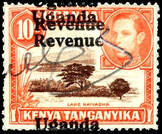 R153aa
R153aa
c1940-49 (see note 1). Similar to previous issue but overprinted Uganda Revenue in seriffed font (Uganda 13½ x 3½ mm, Revenue 14½ x 2½ mm). Various perfs.
R151. 1c black and chocolate-brown (perf 13¼ x 13¾)
R152. 5c black and green (perf 13 x 11¾)
R153. 10c red-brown and orange (perf 13 x 11¾)
aa. Overprint double
a. Perf 14
R154. 10c black and green (perf 13 x 11¾)
R155. 20c black and orange (perf 13¼)
a. Perf 14
b. Perf 13¼ x 13¾
R156. 50c purple and black (perf 13 x 11¾)
a. Reddish purple and black, perf 13 x 12½
R157. 1s black and yellowish brown (perf 13 x 11¾)
a. Red overprint
b. Blue overprint
c. Black opt on 1s black and brown, perf 13 x 11¾
d. Black opt on 1s perf 13 x 12½
R158. 2s lake-brown and brown-purple (perf 13¼)
a. Perf 14
b. Perf 13¾ x 13¼
R159. 3s dull ultramarine and black (perf 13 x 11¾)
R160. 5s black and carmine (perf 13¼)
a. Red overprint
b. Black opt on 5s perf 14
c. Red opt on 5s perf 14
d. Black opt on 5s perf 13¼ x 13¾
R161. 10s purple and blue (perf 13¼)
a. Black opt on 10s reddish purple and blue, perf 14
b. Red opt on 10s reddish purple and blue, perf 14
c. Black opt on 10s perf 13¼ x 13¾
Notes:
1. Although no official documentation and hardly any dated examples of this issue are known, the dates of issue can be determined reasonably well by looking at the unoverprinted postage stamps which correspond to the revenues. The stamps overprinted to produce R155, R160 and R161 (listed by Gibbons as SG 139, 148 and 149) were issued in 1938 but ran out and had to be replaced in 1941 with the perf 14 stamps. This strongly suggests that the overprint was in use by 1941. The stamps overprinted to produce R154, R156a and R157d did not appear until 1949. The new 10c postage stamp (SG 135) quickly ran out and was replaced with a new perf (SG 135c) in 1950, but this stamp is found only with the smaller revenue overprint (see R171 below). From this I infer that the larger overprint was replaced by the smaller overprint around the end of the 1940s.
2. R152, R153, R154, R157c and R157d are known postally used.
3. Barefoot lists the 50c overprinted in blue, but I have not seen this.
R151. 1c black and chocolate-brown (perf 13¼ x 13¾)
R152. 5c black and green (perf 13 x 11¾)
R153. 10c red-brown and orange (perf 13 x 11¾)
aa. Overprint double
a. Perf 14
R154. 10c black and green (perf 13 x 11¾)
R155. 20c black and orange (perf 13¼)
a. Perf 14
b. Perf 13¼ x 13¾
R156. 50c purple and black (perf 13 x 11¾)
a. Reddish purple and black, perf 13 x 12½
R157. 1s black and yellowish brown (perf 13 x 11¾)
a. Red overprint
b. Blue overprint
c. Black opt on 1s black and brown, perf 13 x 11¾
d. Black opt on 1s perf 13 x 12½
R158. 2s lake-brown and brown-purple (perf 13¼)
a. Perf 14
b. Perf 13¾ x 13¼
R159. 3s dull ultramarine and black (perf 13 x 11¾)
R160. 5s black and carmine (perf 13¼)
a. Red overprint
b. Black opt on 5s perf 14
c. Red opt on 5s perf 14
d. Black opt on 5s perf 13¼ x 13¾
R161. 10s purple and blue (perf 13¼)
a. Black opt on 10s reddish purple and blue, perf 14
b. Red opt on 10s reddish purple and blue, perf 14
c. Black opt on 10s perf 13¼ x 13¾
Notes:
1. Although no official documentation and hardly any dated examples of this issue are known, the dates of issue can be determined reasonably well by looking at the unoverprinted postage stamps which correspond to the revenues. The stamps overprinted to produce R155, R160 and R161 (listed by Gibbons as SG 139, 148 and 149) were issued in 1938 but ran out and had to be replaced in 1941 with the perf 14 stamps. This strongly suggests that the overprint was in use by 1941. The stamps overprinted to produce R154, R156a and R157d did not appear until 1949. The new 10c postage stamp (SG 135) quickly ran out and was replaced with a new perf (SG 135c) in 1950, but this stamp is found only with the smaller revenue overprint (see R171 below). From this I infer that the larger overprint was replaced by the smaller overprint around the end of the 1940s.
2. R152, R153, R154, R157c and R157d are known postally used.
3. Barefoot lists the 50c overprinted in blue, but I have not seen this.
c1946-50. Similar to R147/e but overprinted UGANDA REVENUE in seriffed capitals (UGANDA 12½ x 2 mm, REVENUE 15 x 2 mm). Perf 14. Chalk-surfaced paper.
R166. £1 black and red (yellow opt)
a. Silver overprint
Note: these stamps and the subsequent issue (R180) appear to come from the post-war printings on thin chalky paper, unlike the thicker chalky paper which is found on R147a.
R166. £1 black and red (yellow opt)
a. Silver overprint
Note: these stamps and the subsequent issue (R180) appear to come from the post-war printings on thin chalky paper, unlike the thicker chalky paper which is found on R147a.
c1950-52. Similar to R151/160 but overprinted Uganda Revenue in smaller seriffed font (Uganda 11½ x 3 mm, Revenue 13 x 2½ mm). Overprinted in blue (£1) or black (others). Perf 14 (first 5s and £1), perf 13 x 11¾ (first 1s), perf 13¾ x 13¼ (2s), perf 13¼ x 13¾ (20c, second 5s and 10s) or perf 13 x 12½ (others). Chalk-surfaced paper (£1).
R171. 10c black and green
a. Missing final a in Uganda
R172. 10c brown and grey
a. Double overprint
b. Missing final a in Uganda
c. Missing final a in Uganda and final ue in Revenue
R173. 20c deep black and deep orange
R174. 50c reddish purple and black
R175. 1s black and brown (perf 13 x 11¾)
a. Deep black and brown, perf 13 x 12½
R176. 2s lake-brown and brown-purple
R177. 3s deep violet-blue and black
R178. 5s black and carmine (perf 14)
a. Double overprint, one diagonal (perf 14)
b. Perf 13¼ x 13¾
R179. 10s purple and blue
R180. £1 black and red (blue opt)
Notes:
1. For a discussion of dates of issue, see note 1 below R160c.
2. R171 and R172 are known postally used.
3. The Foreign and Commonwealth Office in the British Library contains an example of the 3s with this overprint but perf 13 x 11¾. No issued examples are known in this perforation.
R171. 10c black and green
a. Missing final a in Uganda
R172. 10c brown and grey
a. Double overprint
b. Missing final a in Uganda
c. Missing final a in Uganda and final ue in Revenue
R173. 20c deep black and deep orange
R174. 50c reddish purple and black
R175. 1s black and brown (perf 13 x 11¾)
a. Deep black and brown, perf 13 x 12½
R176. 2s lake-brown and brown-purple
R177. 3s deep violet-blue and black
R178. 5s black and carmine (perf 14)
a. Double overprint, one diagonal (perf 14)
b. Perf 13¼ x 13¾
R179. 10s purple and blue
R180. £1 black and red (blue opt)
Notes:
1. For a discussion of dates of issue, see note 1 below R160c.
2. R171 and R172 are known postally used.
3. The Foreign and Commonwealth Office in the British Library contains an example of the 3s with this overprint but perf 13 x 11¾. No issued examples are known in this perforation.
 R172 (left) and R181 (right) enlarged for comparison
R172 (left) and R181 (right) enlarged for comparison
c1954. As previous issue but overprinted Uganda Revenue in a new type of seriffed font, similar to that found on R151/60c but slightly smaller (Uganda 12 x 3 mm, Revenue 14 x 2½ mm). Perf 13 x 12½.
R181. 10c brown and grey
Note: the overprint found on R181 is the same type as was used on the QEII issue (see R191/8).
R181. 10c brown and grey
Note: the overprint found on R181 is the same type as was used on the QEII issue (see R191/8).
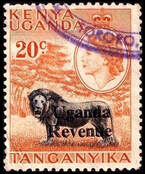 R192a
R192a
c1954-57. Queen Elizabeth II first pictorial issue, with two-line seriffed Uganda Revenue overprint (Uganda 12 x 3 mm, Revenue 14 x 2½ mm). Perf 12½ x 13 (10c to 1s), perf 13 x 12½ (2s to 10s), perf 13½ x 13 (£1). Watermark Multiple Script CA. Overprinted locally by unknown printer.
R191. 10c carmine-red
a. Overprint inverted
R192. 20c black and orange
a. Overprinted as R171/80
R193. 50c reddish purple
R194. 1s black and claret
a. Double overprint
b. Major misplacement of overprint
c. Revenue omitted in overprint
R195. 2s black and green
R196. 5s black and orange
R197. 10s black and deep ultramarine
R198. £1 brown-red and black
Notes:
1. R194a is known postally used on test covers sent by E M Berry Esq of Lytham St Annes, England to himself via an agent in Kampala. Six such covers were sent, according to a stamp news cutting quoted by Hoffman.
2. Barefoot lists the 2s stamp overprinted UGANDA REVENUE in capitals, either upright or sideways. I have not seen these stamps, though they sound very similar to R5/a and R11 of Kenya, and might possibly be an erroneous listing for these.
R191. 10c carmine-red
a. Overprint inverted
R192. 20c black and orange
a. Overprinted as R171/80
R193. 50c reddish purple
R194. 1s black and claret
a. Double overprint
b. Major misplacement of overprint
c. Revenue omitted in overprint
R195. 2s black and green
R196. 5s black and orange
R197. 10s black and deep ultramarine
R198. £1 brown-red and black
Notes:
1. R194a is known postally used on test covers sent by E M Berry Esq of Lytham St Annes, England to himself via an agent in Kampala. Six such covers were sent, according to a stamp news cutting quoted by Hoffman.
2. Barefoot lists the 2s stamp overprinted UGANDA REVENUE in capitals, either upright or sideways. I have not seen these stamps, though they sound very similar to R5/a and R11 of Kenya, and might possibly be an erroneous listing for these.
c1956-60. Same basic issue with very similar overprint (see illustration above R191 for differences), but produced in London by De La Rue.
a) Wmk Multiple Script CA
R201. 10c carmine-red (1956)
R202. 20c black and orange (1957)
b) Wmk Multiple Block CA
R206. 10c carmine-red
R207. 20c black and yellow-orange
Notes:
1. Essays for these overprints can be found in the Crown Agents archive in the British Library, where De La Rue is identified as the printer. They were evidently issued to replenish the stocks of the original locally overprinted stamps. The DLR overprint is almost identical in size and font to the original type; the difference between the two types can be seen most clearly in the final three letters of the word Revenue.
2. R206/7 were discovered by Rick Green in April 2011. These stamps were not issued on block CA paper without the Uganda Revenue overprint, and it is not known when the block CA paper was introduced. A marginal note against Req 8039/1 (see list of printings below) specifies the use of this paper but it was probably already in use from 1960 or 1961.
3. Plate numbers recorded: 10c (R206) 5B, 20c (R207) 4-6. The 20c with 4-6 plate combination has not been recorded without the overprint.
Printings for R201/7:
(Note: this list is probably incomplete and will be added to in future)
a) Wmk Multiple Script CA
R201. 10c carmine-red (1956)
R202. 20c black and orange (1957)
b) Wmk Multiple Block CA
R206. 10c carmine-red
R207. 20c black and yellow-orange
Notes:
1. Essays for these overprints can be found in the Crown Agents archive in the British Library, where De La Rue is identified as the printer. They were evidently issued to replenish the stocks of the original locally overprinted stamps. The DLR overprint is almost identical in size and font to the original type; the difference between the two types can be seen most clearly in the final three letters of the word Revenue.
2. R206/7 were discovered by Rick Green in April 2011. These stamps were not issued on block CA paper without the Uganda Revenue overprint, and it is not known when the block CA paper was introduced. A marginal note against Req 8039/1 (see list of printings below) specifies the use of this paper but it was probably already in use from 1960 or 1961.
3. Plate numbers recorded: 10c (R206) 5B, 20c (R207) 4-6. The 20c with 4-6 plate combination has not been recorded without the overprint.
Printings for R201/7:
- Req 3758/1 (date not recorded): 20c
- Req 8251/1: 10c, 20c, 1s, 2s – ORDER CANCELLED
- Req 6841/1 (sent to Uganda 17th February to 4th March 1958): 10c, 20c
- Req 8260/1 (sent to Uganda 4th to 22nd December 1958): 10c, 20c
- Req 9308/1 (sent to Uganda 12th February 1960): 10c, 20c
- Req 9972/1 (sent to Uganda 26th January to 9th February 1961): 10c, 20c
- Req 1085/1 (sent to Uganda 31st August 1962 to 18th February 1963): 10c
- Req 1495/1 (sent to Uganda 14th May 1963): 10c
- Req 8039/1 (sent to Uganda 13th November 1963): 10c
(Note: this list is probably incomplete and will be added to in future)
c1960. Queen Elizabeth II second pictorial issue overprinted Uganda Revenue. Perf 15 x 14 (cents values) or perf 14½ (shillings values). Watermark Multiple Crown and Block CA.
a) Overprint in mixed case (Uganda 12 x 3 mm, Revenue 14 x 2½ mm)
R213. 1s deep reddish violet and reddish purple (red)
R214. 2s deep grey-blue and greenish blue (red)
b) Overprint in small sans-serif capitals (UGANDA 10½ x 1½ mm, REVENUE 12 x 1½ mm)
R221. 10c yellow-green
R222. 50c slate-violet
R223. 1s deep reddish violet and reddish purple (red)
a. Black overprint
R224. 2s deep grey-blue and greenish blue (red)
Note: Gibson additionally lists the 10c, 20c and 50c with mixed case overprint, but I have not seen these.
a) Overprint in mixed case (Uganda 12 x 3 mm, Revenue 14 x 2½ mm)
R213. 1s deep reddish violet and reddish purple (red)
R214. 2s deep grey-blue and greenish blue (red)
b) Overprint in small sans-serif capitals (UGANDA 10½ x 1½ mm, REVENUE 12 x 1½ mm)
R221. 10c yellow-green
R222. 50c slate-violet
R223. 1s deep reddish violet and reddish purple (red)
a. Black overprint
R224. 2s deep grey-blue and greenish blue (red)
Note: Gibson additionally lists the 10c, 20c and 50c with mixed case overprint, but I have not seen these.
c1962. Independence issue overprinted Uganda Revenue. Perf 15 x 14 (cents values) or perf 14½ (shillings values). No watermark.
a) Overprint in capitals
R231. 20c plum and buff (red)
R232. 50c black and turquoise-green (red)
R233. 1s sepia, red and turquoise-green
R234. 2s black, carmine and light blue
b) Overprint in mixed case
R241. 1s sepia, red and turquoise-green (red)
R242. 2s black, carmine and light blue (red)
a. Yellow-orange overprint
Notes:
1. Overprint dimensions are as follows:
a) Overprint in capitals
R231. 20c plum and buff (red)
R232. 50c black and turquoise-green (red)
R233. 1s sepia, red and turquoise-green
R234. 2s black, carmine and light blue
b) Overprint in mixed case
R241. 1s sepia, red and turquoise-green (red)
R242. 2s black, carmine and light blue (red)
a. Yellow-orange overprint
Notes:
1. Overprint dimensions are as follows:
- All-capitals overprint - cents values: UGANDA 10½ x 1½ mm, REVENUE 12 x 1½ mm
- All-capitals overprint - shilling values: UGANDA 16½ x 2½ mm, REVENUE 18½ x 2½ mm
- Mixed-case overprint: Uganda 12 x 3 mm, Revenue 14 x 2½ mm
1965. Birds pictorial issue overprinted Uganda Revenue. Perf 15 x 14 (cents values) or perf 14½ (shillings values). No watermark.
a) Overprint in capitals
R251. 10c chestnut, black and light blue (blue)
R252. 20c multicoloured
R253. 50c grey-blue and reddish violet
R254. 1s multicoloured (red)
R255. 20s multicoloured (red)
b) Overprint in mixed case
R261. 1s multicoloured (red)
R262. 5s multicoloured (red)
Notes:
1. Three different all-capitals overprints were used, as follows:
a) Overprint in capitals
R251. 10c chestnut, black and light blue (blue)
R252. 20c multicoloured
R253. 50c grey-blue and reddish violet
R254. 1s multicoloured (red)
R255. 20s multicoloured (red)
b) Overprint in mixed case
R261. 1s multicoloured (red)
R262. 5s multicoloured (red)
Notes:
1. Three different all-capitals overprints were used, as follows:
- 10c - seriffed, UGANDA 14 x 2 mm, REVENUE 15 x 2 mm
- 20c & 50c - sans-serif, UGANDA 10½ x 1½ mm, REVENUE 12 x 1½ mm
- 1s and 20s - seriffed, UGANDA 16½ x 2½ mm, REVENUE 18½ x 2½ mm
- 1s - Uganda 12 x 3 mm, Revenue 14 x 2½ mm
- 5s - Uganda 11½ x 3 mm, Revenue 12½ x 2½ mm
 R273 proof
R273 proof
1966. New key type featuring Crowned Crane, inscribed UGANDA REVENUE. 15½ x 19½ mm. Perf 13.
a) Watermark Multiple Crown and Block CA (1966-70)
R271. 10c brown-orange
R272. 20c blue
[R273. 25c red-brown]
R274. 30c brown-purple
R275. 50c rose
R276. 1s bistre
R277. 2s greenish blue
R278. 5s slate-violet
R279. 10s green
R280. 20s carmine
b) Wmk Block CA diagonal (rather faint) and PVA gum (c1970)
R282. 20c blue
Notes:
1. The issue date for R271/80 given here is based on the approval dates for the printer's proofs, which are held in the Crown Agents archives for all values except the 2s. Colours for the original requisition (30c to 20s) were approved between 28th September 1965 and 4th February 1966. The three lowest values were ordered a few months later, the 20c proof being approved on 16th June 1966 and the 10c and 25c on 29th July 1966.
2. The 25c value recorded in the Requisition Books has not yet been seen as an issued stamp. Two additional values (5c and 3s) were later commissioned for the set but cancelled before the order was fulfilled.
3. Gibson (citing the 2000 edition of Barefoot) mentions a 1970 reprint on unwatermarked paper, but I have not seen these and they are not listed in later editions of Barefoot.
4. The watermark on R282 is so faint that I originally mistook it as wmk Arms of Uganda and listed it as such along with a 10c in the same watermark. The latter has now been deleted since I confirmed that my supposed example was in fact R271. Barefoot lists six further values (10c and 50c to 20s) with CA diagonal wmk but I have not seen these.
Printings (dates of dispatch not recorded):
(Note: this list is probably incomplete and will be added to in future)
a) Watermark Multiple Crown and Block CA (1966-70)
R271. 10c brown-orange
R272. 20c blue
[R273. 25c red-brown]
R274. 30c brown-purple
R275. 50c rose
R276. 1s bistre
R277. 2s greenish blue
R278. 5s slate-violet
R279. 10s green
R280. 20s carmine
b) Wmk Block CA diagonal (rather faint) and PVA gum (c1970)
R282. 20c blue
Notes:
1. The issue date for R271/80 given here is based on the approval dates for the printer's proofs, which are held in the Crown Agents archives for all values except the 2s. Colours for the original requisition (30c to 20s) were approved between 28th September 1965 and 4th February 1966. The three lowest values were ordered a few months later, the 20c proof being approved on 16th June 1966 and the 10c and 25c on 29th July 1966.
2. The 25c value recorded in the Requisition Books has not yet been seen as an issued stamp. Two additional values (5c and 3s) were later commissioned for the set but cancelled before the order was fulfilled.
3. Gibson (citing the 2000 edition of Barefoot) mentions a 1970 reprint on unwatermarked paper, but I have not seen these and they are not listed in later editions of Barefoot.
4. The watermark on R282 is so faint that I originally mistook it as wmk Arms of Uganda and listed it as such along with a 10c in the same watermark. The latter has now been deleted since I confirmed that my supposed example was in fact R271. Barefoot lists six further values (10c and 50c to 20s) with CA diagonal wmk but I have not seen these.
Printings (dates of dispatch not recorded):
- Req 4/89140/1: 30c, 50c, 1s, 2s, 5s, 10s, 20s
- Req 6/56539/1: 20c
- Req 7/21108/1: 10c, 25c, 50c, 1s, 2s, 5s, 10s, 20s
- Req 8/08734/1: No details recorded
- Req 8/51282/1: No details recorded
- Req 0/03725/1: 10c, 20c, 50c, 1s, 10s, 20s
(Note: this list is probably incomplete and will be added to in future)
Revenue usage of Postage stamps
Note: for ease of reference, numbering follows the Stanley Gibbons Part 1 catalogue throughout this section. Values listed here are those recorded as having been used for revenue purposes.
Note: for ease of reference, numbering follows the Stanley Gibbons Part 1 catalogue throughout this section. Values listed here are those recorded as having been used for revenue purposes.
1896. Typeset postage stamps (produced by Revd F Rowling). Imperf. No watermark.
S55. 1a black
S56. 2a black
S58. 4a black
S59. 8a black
S60. 1r black
S61. 5r black
Same types overprinted L (= local)
S74. 8a black
S75. 1r black
The above stamps are usually cancelled with the Coat of Arms cancel of the British Vice Consul in the Uganda Protectorate and the adjoining territories.
S55. 1a black
S56. 2a black
S58. 4a black
S59. 8a black
S60. 1r black
S61. 5r black
Same types overprinted L (= local)
S74. 8a black
S75. 1r black
The above stamps are usually cancelled with the Coat of Arms cancel of the British Vice Consul in the Uganda Protectorate and the adjoining territories.
1898-1902. Queen Victoria stamps inscribed Uganda Protectorate. Perf 14. Wmk Crown CA (1a) or Crown CC (rupee values).
S84. 1a scarlet
S90. 1r dull blue
S91. 5r brown
Note: for this issue overprinted IR in manuscript, see above R1.
1902. Similar type of British East Africa overprinted Uganda in red.
S93. 2½a deep blue
S84. 1a scarlet
S90. 1r dull blue
S91. 5r brown
Note: for this issue overprinted IR in manuscript, see above R1.
1902. Similar type of British East Africa overprinted Uganda in red.
S93. 2½a deep blue
Uganda Railway Telegraphs
Note: the stamps listed here should technically be regarded as Kenya Telegraphs, since they were used only in Kenya. The inscription Uganda Railway refers to the line which went through Kenya in the direction of the Ugandan border. I follow Hiscocks in listing them under Uganda for convenience.
Note: the stamps listed here should technically be regarded as Kenya Telegraphs, since they were used only in Kenya. The inscription Uganda Railway refers to the line which went through Kenya in the direction of the Ugandan border. I follow Hiscocks in listing them under Uganda for convenience.
1902 (according to Hiscocks). Typeset. Pin perf 12. No watermark. Each stamp has identical upper and lower halves. Used examples are usually upper half only.
a) Inscribed UGANDA Railway TELEGRAPHS; complete stamp measures 26 x 64 mm
T1. 2a black on greenish blue
T2. 4a black on buff
T3. 6a black on magenta
T4. 8a black on rose
T5. 12a black on grey
b) Inscribed TELEGRAPHS UGANDA RAILWAY; complete stamp measures 30 x 62 mm
T6. 1r black on cream
T7. 2r black on buff
T8. 3r black on greenish blue
T9. 4r black on magenta
T10. 5r black on rose
T11. 10r black on grey
T12. 20r black on cream
Note: The Stanley Gibbons Part 1 catalogue follows Hiscocks in listing several constant plate varieties on this issue.
a) Inscribed UGANDA Railway TELEGRAPHS; complete stamp measures 26 x 64 mm
T1. 2a black on greenish blue
T2. 4a black on buff
T3. 6a black on magenta
T4. 8a black on rose
T5. 12a black on grey
b) Inscribed TELEGRAPHS UGANDA RAILWAY; complete stamp measures 30 x 62 mm
T6. 1r black on cream
T7. 2r black on buff
T8. 3r black on greenish blue
T9. 4r black on magenta
T10. 5r black on rose
T11. 10r black on grey
T12. 20r black on cream
Note: The Stanley Gibbons Part 1 catalogue follows Hiscocks in listing several constant plate varieties on this issue.
